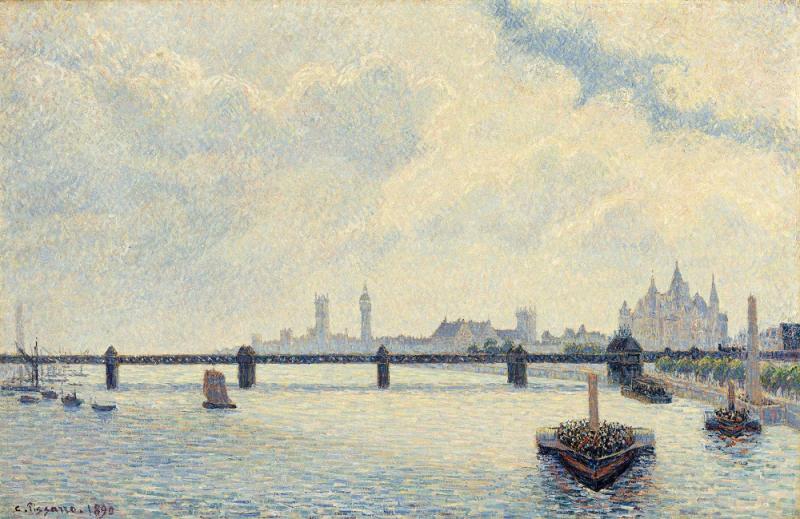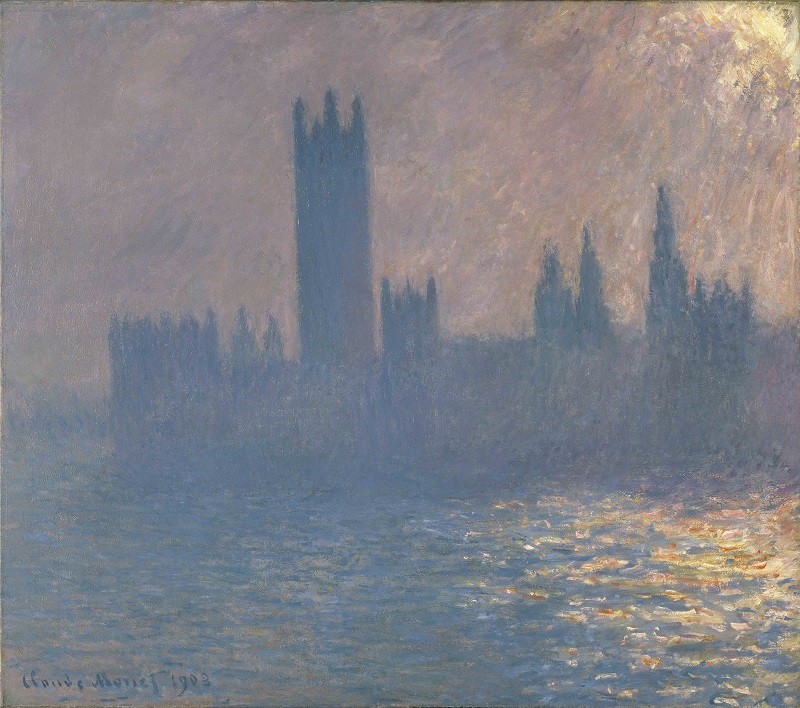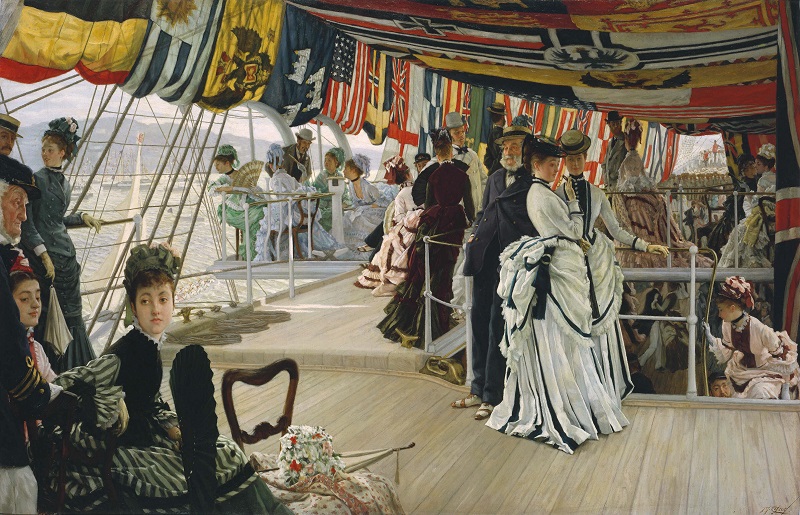Impressionists in London, Tate Britain review - from the stodgy to the sublime | reviews, news & interviews
Impressionists in London, Tate Britain review - from the stodgy to the sublime
Impressionists in London, Tate Britain review - from the stodgy to the sublime
Monet's Westminster views lead an anthology of lesser painters

Jules Dalou, Edouard Lantéri, Jean-Baptiste Carpeaux, Charles-François Daubigny, Alphonse Legros, Giuseppe de Nittis?
Not only did some 230,000 or more combatants and civilians die, but many a familiar landmark was pulverised as central Paris was profoundly damaged. Fearful of conscription, artists like Monet came to London, living in relatively reduced circumstances, their livelihoods threatened as the French art market found itself in serious difficulties. Then, as now, refugees came for political and economic reasons, leaving devastation behind, and hoping for new opportunity.
The cross-channel journeys of the artists led to unexpected consequences. In the penultimate gallery there is a hypnotically beautiful coup de théâtre, late Impressionism at its finest, with six views by Monet of Westminster from 1904, never seen together before in London, and created on trips made some 30 years after his initial temporary exile. This is the largest group to be shown in Europe for nearly half a century, and sensational they are, as are two of his views of Charing Cross. He was transported and inspired, he said, by the changing colours in the fog and rain of London: coal fires were a health hazard but produced beautiful skyborne effects. These are canvases of transcendent beauty: the buildings of Westminster punctuate the urban atmosphere. Monet is that rare creature whose art in the 21st century looks ever more radical and ever more beautiful. (Pictured below: Claude Monet, Houses of Parliament, Sunlight Effect, 1903, Brooklyn Museum of Art, New York)  The final gallery gives us the coming vibrancy of the modern world. The brilliant coda there is a selection of Thames-scapes, 1906-7, by André Derain, heavily patterned like an imaginative jigsaw puzzle, with stridently brilliant, almost savage, colour. Derain had seen an exhibition of Monet’s views of the Thames at Durand-Ruel’s Paris gallery in 1904, but his views – divisionist, expressionistic – were a striking contrast as art idioms moved on in a push-me, pull-you fashion. His dealer Vollard wanted Dérain to emulate Monet’s success with his new take on views of the Thames.
The final gallery gives us the coming vibrancy of the modern world. The brilliant coda there is a selection of Thames-scapes, 1906-7, by André Derain, heavily patterned like an imaginative jigsaw puzzle, with stridently brilliant, almost savage, colour. Derain had seen an exhibition of Monet’s views of the Thames at Durand-Ruel’s Paris gallery in 1904, but his views – divisionist, expressionistic – were a striking contrast as art idioms moved on in a push-me, pull-you fashion. His dealer Vollard wanted Dérain to emulate Monet’s success with his new take on views of the Thames.
Welcome as the wondrous Monets are, Impressionism is a marketing come-on for this intriguing anthology. The story that Tate reveals is complex, with much presented as visual history: sketchbooks, documentary photographs of the destruction of Paris, beautifully and horrifically detailed. The art varies from the gracefully academic to the almost stodgy – dare one say, boring? – technically accomplished but curiously empty sculptures by Jules Dalou and Jean Baptiste Capeaux.
Each artist has a different story. James (Jean-Jacques) Tissot (1836-1902) had defended Paris in the Franco-Prussian war, become involved with the Commune and moved to London, perhaps to escape political consequences, and also possibly for more success; indeed he exhibited regularly at the Royal Academy. Tissot was a hallucinatory painter (and a skilled watercolourist and printmaker) whose techniques in oil on canvas have much more in common with the Pre-Raphaelites and High Victorians like Lord Leighton, without the moralising overtones. He was a mesmerising social reporter, and moved back to Paris after the death of his beloved mistress Kathleen Newton (pictured below: James Tissot, The Ball on Shipboard, c.1874).  Camille Pissarro (1830-1903), the sage and wise paternal figure to so many of the Impressionists, is here with his wonderfully evocative paintings of south London suburbs, of Kew, and cricket on the lawn: they look so tightly knit compared to the resplendently sensual sweeps of colour deployed by Monet in his London views (main picture: Camille Pissarro, Charing Cross Bridge, 1890). The Anglo-French Albert Sisley (1839-1899) is here too, his home and prospects destroyed by the Prussians.
Camille Pissarro (1830-1903), the sage and wise paternal figure to so many of the Impressionists, is here with his wonderfully evocative paintings of south London suburbs, of Kew, and cricket on the lawn: they look so tightly knit compared to the resplendently sensual sweeps of colour deployed by Monet in his London views (main picture: Camille Pissarro, Charing Cross Bridge, 1890). The Anglo-French Albert Sisley (1839-1899) is here too, his home and prospects destroyed by the Prussians.
This is an exhibition which shows by example the enriching value of welcoming refugees, not to mention visitors from elsewhere, both political and economic. In an age when there were no passport or visa restrictions, some artists had settled earlier. The highly skilled painter and printmaker Alphonse Legros became a Slade professor, and embedded himself in English cultural life. The sculptors Lantéri and Dalou – the latter returned to Paris with great success in 1879 – were also teachers, and influenced the curricula in the London art schools, by virtue of their uncanny skills at modelling. Carpeaux came and went for economic advantage, and also hoping for patronage from the royals of the Second Empire, deposed and in exile in England.
The array of relatively unfamiliar artists is intriguing and informative, giving a rounded view of the period. The high academic competence of these currently relatively disregarded artists can – alas – produce an art lacking in vitality. But this art points out the astonishing nature of the Impressionist experiments, reactions to the prevailing meticulous nature of both painting and sculpture in the landscape of conventional academia. And with a soupçon of Rodin, introduced to an English audience by his French compatriots, we see how even academic correctness could be transcended.
- Impressionists in London, French Artists in Exile (1870-1904) at Tate Britain until 22 April 2018
- Read more visual arts reviews on theartsdesk
rating
Share this article
The future of Arts Journalism
You can stop theartsdesk.com closing!
We urgently need financing to survive. Our fundraising drive has thus far raised £49,000 but we need to reach £100,000 or we will be forced to close. Please contribute here: https://gofund.me/c3f6033d
And if you can forward this information to anyone who might assist, we’d be grateful.

Subscribe to theartsdesk.com
Thank you for continuing to read our work on theartsdesk.com. For unlimited access to every article in its entirety, including our archive of more than 15,000 pieces, we're asking for £5 per month or £40 per year. We feel it's a very good deal, and hope you do too.
To take a subscription now simply click here.
And if you're looking for that extra gift for a friend or family member, why not treat them to a theartsdesk.com gift subscription?
more Visual arts
 'We are bowled over!' Thank you for your messages of love and support
Much-appreciated words of commendation from readers and the cultural community
'We are bowled over!' Thank you for your messages of love and support
Much-appreciated words of commendation from readers and the cultural community
 Lee Miller, Tate Britain review - an extraordinary career that remains an enigma
Fashion photographer, artist or war reporter; will the real Lee Miller please step forward?
Lee Miller, Tate Britain review - an extraordinary career that remains an enigma
Fashion photographer, artist or war reporter; will the real Lee Miller please step forward?
 Kerry James Marshall: The Histories, Royal Academy review - a triumphant celebration of blackness
Room after room of glorious paintings
Kerry James Marshall: The Histories, Royal Academy review - a triumphant celebration of blackness
Room after room of glorious paintings
 Folkestone Triennial 2025 - landscape, seascape, art lovers' escape
Locally rooted festival brings home many but not all global concerns
Folkestone Triennial 2025 - landscape, seascape, art lovers' escape
Locally rooted festival brings home many but not all global concerns
 Sir Brian Clarke (1953-2025) - a personal tribute
Remembering an artist with a gift for the transcendent
Sir Brian Clarke (1953-2025) - a personal tribute
Remembering an artist with a gift for the transcendent
 Emily Kam Kngwarray, Tate Modern review - glimpses of another world
Pictures that are an affirmation of belonging
Emily Kam Kngwarray, Tate Modern review - glimpses of another world
Pictures that are an affirmation of belonging
 Kiefer / Van Gogh, Royal Academy review - a pairing of opposites
Small scale intensity meets large scale melodrama
Kiefer / Van Gogh, Royal Academy review - a pairing of opposites
Small scale intensity meets large scale melodrama
 Jenny Saville: The Anatomy of Painting, National Portrait Gallery review - a protégé losing her way
A brilliant painter in search of a worthwhile subject
Jenny Saville: The Anatomy of Painting, National Portrait Gallery review - a protégé losing her way
A brilliant painter in search of a worthwhile subject
 Abstract Erotic, Courtauld Gallery review - sculpture that is sensuous, funny and subversive
Testing the boundaries of good taste, and winning
Abstract Erotic, Courtauld Gallery review - sculpture that is sensuous, funny and subversive
Testing the boundaries of good taste, and winning
 Edward Burra, Tate Britain review - watercolour made mainstream
Social satire with a nasty bite
Edward Burra, Tate Britain review - watercolour made mainstream
Social satire with a nasty bite
 Ithell Colquhoun, Tate Britain review - revelations of a weird and wonderful world
Emanations from the unconscious
Ithell Colquhoun, Tate Britain review - revelations of a weird and wonderful world
Emanations from the unconscious
 Rachel Jones: Gated Canyons, Dulwich Picture Gallery review - teeth with a real bite
Mouths have never looked so good
Rachel Jones: Gated Canyons, Dulwich Picture Gallery review - teeth with a real bite
Mouths have never looked so good

Add comment